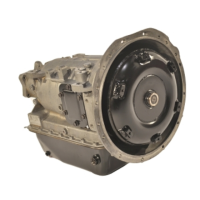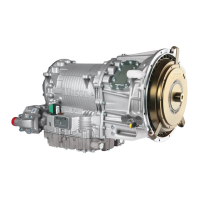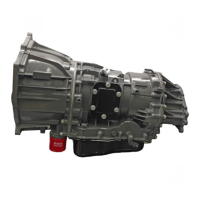Copyright © 1996 General Motors Corp. 2–3
DESCRIPTION AND OPERATION
(3) When the converter turbine rotates and
the forward clutch is applied, the transmission main
shaft is rotated. This drives the transmission gear set,
and drives the output shaft in any forward range.
(4) The forward clutch is engaged only dur-
ing operation in a forward range, and is always paired
with another clutch (either first, second, third, or
fourth). It is disengaged during neutral and reverse.
(5) In neutral, the forward clutch housing ro-
tates, driving the power takeoff, if so equipped. In re-
verse, the forward clutch housing rotates to drive the
fourth clutch (which is applied in combination with
the first clutch to obtain reverse).
(6) For models with retarder, refer also to
Paragraph 2–16.
2–8. FOURTH CLUTCH
a. Description
(Foldout 9,A)
(1) The fourth clutch includes housing as-
sembly 11, piston 8, five external-tanged clutch plates
4, five internal-splined plates 3, and, for models with-
out retarder, backplate 2. For models with retarder, re-
tarder housing 36 (Foldout 8) functions as the fourth
clutch backplate.
(2) Piston 8 (Foldout 9,A) is installed in
housing 13, and retained by sixteen springs 7, retainer
6, and snapring 5. External-tanged plates 4 engage
housing 13. Internal-splined plates 3 are splined to
fourth clutch driving hub 29 (Foldout 8). For models
without retarder, plates 3 and 4 (Foldout 9,A) are re-
tained in housing 13 by clutch backplate 2 and
snapring 1. For models with retarder, plates 3 and 4 are
retained in housing 13 by retarder housing 36 (Foldout
8).
(3) The hub of housing 13 (Foldout 9,A) is
splined to sun gear shaft 3 (Foldout 10,A). The outer
splines on housing 13 (Foldout 9,A) engage internal-
splined plates 3 (Foldout 9,B) of the third clutch.
b. Operation
(Foldout 9,A)
(1) When the fourth clutch is released, inter-
nal-splined plates 3 are free of external-tanged plates
4. Plates 3 rotate independent of housing 13, whether
housing 13 is stopped or has a different speed or direc-
tion of rotation.
(2) When hydraulic pressure is directed to
the piston cavity in housing 13, piston 8 compresses
plates 3 and 4 against backplate 2 or against retarder
housing 36 (Foldout 8). This locks internal-splined
plates 3 (Foldout 9,A) to external-tanged plates 4 and,
in turn, to housing 13.
(3) When the fourth clutch is engaged, it is
locked to fourth clutch driving hub 29 (Foldout 8) and
rotates with the turbine shaft.
(4) In fourth range, turbine shaft rotation is
transmitted to sun gear shaft 3 (Foldout 10,A) and to
transmission main shaft 4 by the engaged forward
clutch. The result is direct drive to the output shaft.
(5) In reverse, turbine shaft rotation is trans-
mitted to sun gear shaft 3 while the first clutch (Fold-
out 10,B) is engaged, resulting in reverse rotation of
the transmission output shaft.
2–9. SECOND AND THIRD CLUTCH
AND CENTER SUPPORT
a. Description
(Foldout 9,B)
(1) Third clutch includes items 1 through 11.
Second clutch includes items 16 through 25. Center
support assembly 13 serves the two clutches. The front
side of support 15 receives third clutch piston 9. The
rear side of support 15 receives second clutch piston
18. Center support 15 directs fluid to both of these
clutches, as well as to the fourth clutch.
(2) External-tanged clutch plates 4 and 23
engage the transmission housing, and are always sta-
tionary. Internal-splined plates 3 of the third clutch en-
gage housing 13 (Foldout 9,A) of the fourth clutch.
Internal-splined plates 24 (Foldout 9,B) of the second
clutch engage the external splines of front planetary
assembly 8 (Foldout 10,A).
b. Operation of Third Clutch
(Foldout 9,B)
(1) When the third clutch is released, inter-
nal-splined plates 3 rotate with fourth clutch housing
13 (Foldout 9,A). The third clutch is released in all
ranges except third.
(2) When hydraulic pressure is directed to
the third clutch piston cavity (front) of center support
15 (Foldout 9,B), piston 9 compresses plates 3 and 4
against backplate 2. This anchors clutch plates 3 and 4,

